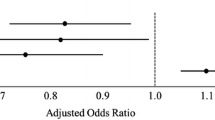Summary
To enhance the quality of treatment of patients with multiple injuries (blunt trauma), guidelines for the acute clinical management (trauma-algorithm) were implemented at our clinic in 1994. The impact of these guidelines was analysed, comparing two prospectively recorded collectives of polytraumatized patients 4/1988–12/1993 (A; n = 126) and 1/1994–6/1996 (B; n = 74). Nine specifically defined parameters were used to assess the therapeutic process of early clinical trauma management. All parameters showed an improvement after implementation of the algorithm (group B): (1) Complete radiological and sonographic basic diagnostics in 97 % vs. 92 % of patients; (2) time interval of 38 min vs. 55 min until cranial CT was done after severe head injury (GCS < 10); (3) reduction of delayed diagnosis of lesions to 5 % vs. 24 %; (4) duration of 16 min vs. 20 min until intubation; (5) period of 23 min to 30 min to pleural drainage; (6) duration of 18 min vs. 32 min until transfusion in shock; (7) period of 79 min vs. 98 min until emergency operation in shock; (8) duration of 95 min vs. 124 min until trepanation, and (9) operation rate within 24 h after admission to ICU in 3 % vs. 12 %. The lethality rates of each collective were assessed after subdivision in three groups (I–III) with middle (ISS: 18–24), high (ISS: 25–49) and extreme (ISS: 50–75) injury severity. In all groups of both collectives ISS values, age, initial loss of consciousness (GCS) and shock were comparable (except the higher injury severity of collective B in group I). In all groups a reduction of lethality could be shown for collective B: Group I, 0 % vs. 20 % (P < 0.05); group II, 8 % vs. 24 % (P < 0.05); and group III, 40 % vs. 71 %, not significant because of the small group in B (n = 5). The implementation of therapeutic management guidelines led to an improvement of both treatment processes and outcome. In order to regularly reassess validity and practicability of such guidelines as well as further enhance therapeutic quality, a continuous evaluation programme representing a quality management system should be inaugurated.
Zusammenfassung
Zur Optimierung der Akutversorgung Polytraumatisierter erfolgte im Jahre 1994 die Einführung von problem- und prioritätenorientierten Behandlungsleitlinien (Polytraumaalgorithmus) in der eigenen Klinik. Die Bedeutung dieser Behandlungsleitlinien wurde vergleichend für 2 prospektiv erfaßte Kollektive 4/1988–12/1993 (A ; n = 126) und 1/1994–6/1996 (B; n = 74) analysiert. Anhand neun definierter Parameter wurde der Versorgungsablauf der frühklinischen Polytraumabehandlung beurteilt. Für alle 9 Beurteilungsparameter zeigten sich Verbesserungen nach Einführung des Algorithmus (Kollektiv B) gegenüber der Kontrollgruppe: 1. Vollständige radiologische und sonographische Basisdiagnostik bei 97 vs. 91 % der Patienten; 2. Dauer von 38 vs. 55 min bis zum kraniellen CT bei schwerem SHT (GCS < 10); 3. Reduktion verzögert diagnostizierter Läsionen auf 5 vs. 32 %; 4. Dauer von 16 vs. 20 min bis zur Intubation; 5. Dauer von 23 vs. 30 min bis zur Thoraxdrainage; 6. Dauer von 18 vs. 32 min bis zur Transfusion bei Schock; 7. Dauer von 79 vs. 98 min bis zur Notoperation bei Schock; 8. Dauer von 95 vs. 124 min bis zur Trepanation; 9. Operationsrate innerhalb von 24 h nach ICU-Aufnahme von 3 vs. 11 %. Die Letalitätsraten der Kollektive wurden nach Unterteilung in 3 Gruppen (I–III) mit mittlerer (ISS: 18–24), hoher (ISS: 25–49) und sehr hoher (ISS: 50–75) Verletzungsschwere gegenübergestellt. ISS-Werte, Alter, initiale Bewußtlosigkeit und Schock waren in allen Gruppen für beide Kollektive vergleichbar (mit Ausnahme einer höheren Verletzungsschwere von Kollektiv B in Gruppe I). In allen Gruppen zeigte sich ein deutlicher Rückgang der Letalität für das Kollektiv B. Gruppe I: 0 vs. 20 %, (p < 0,05); Gruppe II: 8 vs. 24 %, (p < 0,05); Gruppe III 40 vs. 71 %, aufgrund niedriger Fallzahl (n = 5) in B nicht signifikant. Durch Behandlungsleitlinien konnten Versorgungsabläufe optimiert und Behandlungsergebnisse verbessert werden. Um solche Leitlinien in ihrer Gültigkeit und Praktikabilität regelmäßig zu überprüfen, sowie gleichzeitig die Qualität weiter zu optimieren, ist eine kontinuierliche Überprüfung der Behandlung im Sinne eines Qualitätsmanagementsystems zu fordern.
Similar content being viewed by others
Author information
Authors and Affiliations
Rights and permissions
About this article
Cite this article
Ruchholtz, S., Zintl, B., Nast-Kolb, D. et al. Quality management in the early treatment of patients with multiple injuries. II. Quality improvement guidelines. Unfallchirurg 100, 859–866 (1997). https://doi.org/10.1007/s001130050205
Issue Date:
DOI: https://doi.org/10.1007/s001130050205




